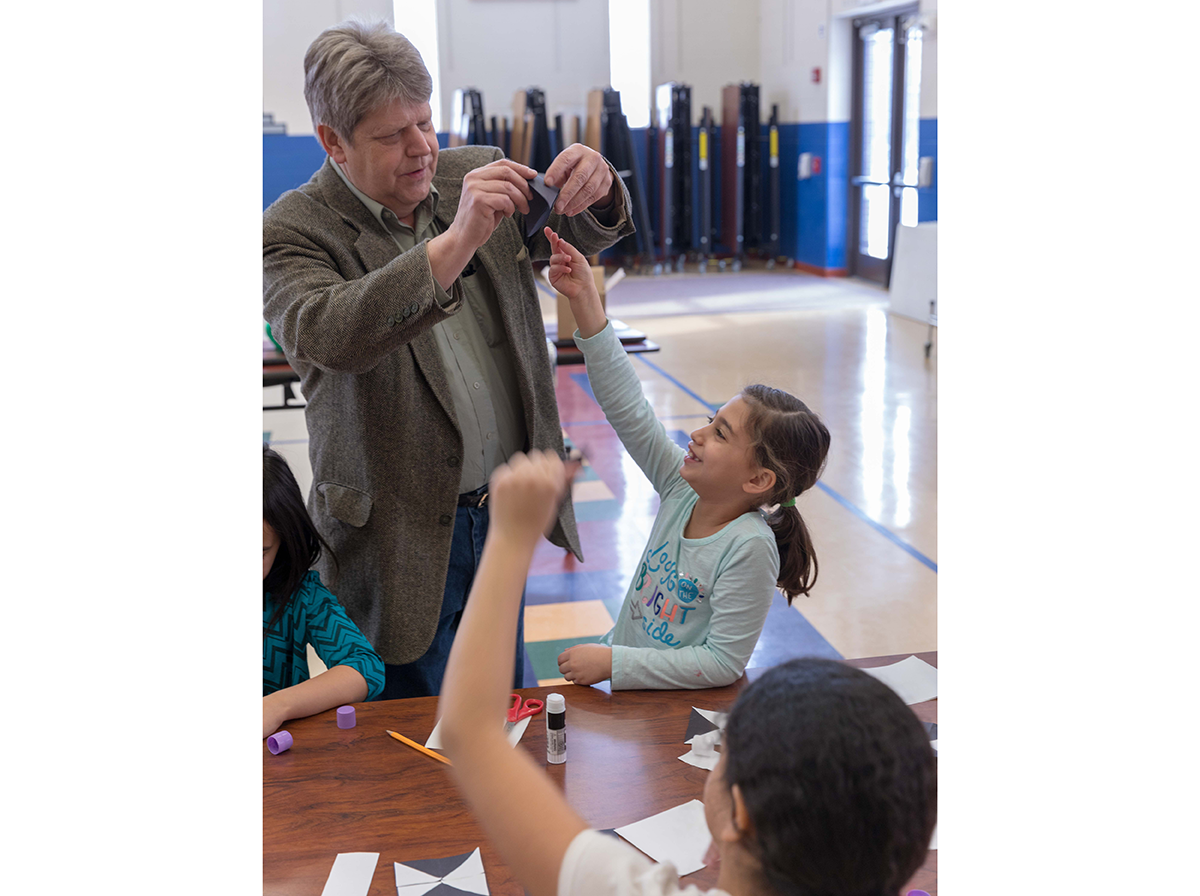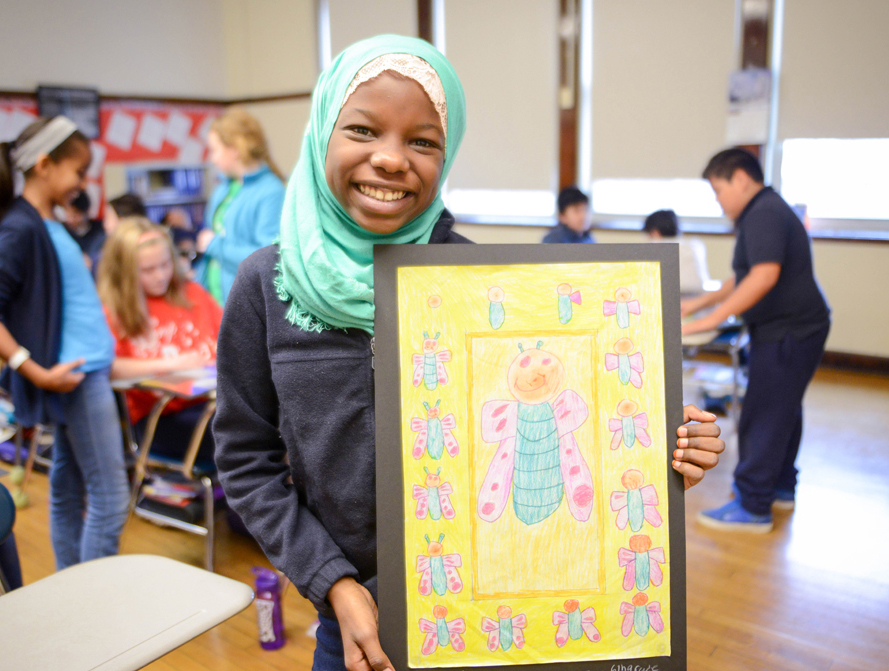A Chicago Teaching Artist since 1980, Bill Eller retired just last month (February 2020) – and while we’re thrilled for him and the world travels that make up his next adventure, we couldn’t let him go without a reflection on his long and impactful career.
A 1979 MFA graduate from the School of the Art Institute of Chicago and a working visual artist ever since, Bill started as a Teaching Artist with the Chicago Public School Art Society (later re-named Art Resources in Teaching or A.R.T.) in January 1980; A.R.T. merged with Urban Gateways in 2013, and Bill has worked with Urban Gateways since then. Between 1980 and 2020 he worked in roughly 250 Chicago-area schools, and he has mentored a number of other Teaching Artists along the way. Scroll down for Bill’s thoughts – and check out this map that he marked with school partners over the years!

Urban Gateways: Tell us about your own arts practice. What do you create?
Bill Eller: Predominantly when I started in the 80s, I was doing painted sculptures. Then for a number of years, I made narrative artwork – series of paintings; 140 paintings was the most I ever did, and the longest project took me 3.5 years. A lot of it has been small-scale pieces. Check out my website to see some of my work.
Since 2014, I’ve been doing altered photographs that look like paintings. They’re all abstract and done with layering of different photos.
I’ve shown at the Chicago Cultural Center, the Minnesota Museum of American Art, and College of DuPage [among others].
Can you describe some of the types of projects and programs you’ve done in schools over the years?
Practically anything. Art + science, art + literature, art + math, comics, murals, large-scale sculpture…I’m not someone who says “This is what I do.” I say, “I can do this.” This is one reason I’ve always had work. I just don’t do computer-based arts. I’m not the guy for that.
Beyond that, I do whatever’s called for. It’s often a product of what the school is looking for. During planning meetings with teachers, I’ll ask about curriculum. If all the projects they’re doing are around Chicago, I’ll use that – or at one school it was all about motion, so we did kinetic sculptures. Or the topic is identity, so we do self-portraits in many directions (representative, abstract, photography, etc).
Pictured: A student with her rug design during the World Weavers program with Teaching Artist Bill Eller at Stone Academy in 2015 – read more about this program below. Photo by Alayna Kudalis.
Can you talk about a project or program from your Teaching Artist career that has been especially impactful, for you or for the students involved?
Sometime in the 90s, one of the Minasian brothers [Armen and Carnig Minasian, of Minasian Rug Company in Evanston] met a writer named Tomie dePaola on an airplane; he happened to be working on a children’s book about carpet-making in the Middle East. So I got called into a meeting through Art Resources in Teaching (A.R.T.); we thought we could do a program in which students created their own carpet designs. The Minasians said, not only that, we could have some of them made! That’s how the World Weavers program was born.
Then when A.R.T. merged with Urban Gateways, we wanted to kick off the program again in 2013-14, starting with one school. We chose Stone Academy [in the West Ridge neighborhood] because the student population was so diverse, and the school was excited about the program. So we did it with them for six years. We’d hear from parents who were excited when their students were old enough to be part of the project. Teachers told me it was their favorite project in the arts each year. Now the program has expanded to McCutcheon Elementary [in Uptown].
For the majority of the students, textile arts is a completely foreign idea that they never even thought about. So they say, wow, this is really different! And when they realize it’s done all over the world – some students realize their parents have handmade rugs, prayer rugs, etc. One girl couldn’t believe it that Carnig Minasian had visited a tiny town in Turkey where her grandma came from.
The students find it really interesting; it’s all new. The whole idea is new. So after you get through some of the introduction, it becomes an art + design project where they create their own rug designs. I’ve had a number of students tell me they’ve never worked harder on anything in their lives than they did on that. They say, I don’t care if I win, this is just so cool what I’ve created.
Each year experts from Minasian Rug Company choose winning designs that are woven into rugs by artisans in Afghanistan; the completed rugs are returned to the school. Schools have also used photos of student designs to frame and hang in their hallways. They’ve even made packets of greeting cards using the design photos!
Read more about World Weavers >>
What are the challenges of being a Teaching Artist? Why did you choose to stick with it?
Being a contract employee for several places at once is a challenge. The other big challenge is traveling all over the city. The benefit being, I’ve learned the entire city of Chicago.
I stuck with it because I found I was actually good at it. One of the stories I always tell: My first year teaching, May 1980, I was at Nobel Elementary working with a 1st grade classroom. The teacher said, ‘Do you notice that student over there? He hasn’t said one word the entire year until you showed up. All of a sudden he started talking with other students, asking and answering questions, and doing that in other classes too.’ That’s when I realized, maybe something about what we do can have an impact.
On a sadder note, I collaborated on a writing and book-making program in another school, and an 8-year-old made this entire book – he wrote and drew everything – and it was all about how he couldn’t save his best friend from being shot. It was an outlet for him, being able to tell that story.
Once I had a 7th grader tell me this was the most amazing class he ever had. He told me, “I have so much to think about!” I hear things like that all the time and it keeps you going.

Pictured: Bill leading a visual arts workshop through Urban Gateways at Oak Terrace Elementary in Highwood, IL, January 2018. Photo by Danny Howard.
How have you seen Chicago schools change over the years? How has the role of a Teaching Artist changed?
The schools are not as crowded as they used to be; I literally taught classes where kids were in hallways. I would sometimes have 4 classes at a time in an auditorium, because there were so many kids trying to do those programs. That doesn’t happen as much anymore. So that’s been a big change. Some of the schools, populations have dropped.
Another thing is, I’ve seen the higher-performing schools just get better because they have all these advantages. The other schools, that’s not necessarily true.
When I was hired in January 1980, my first day of teaching, the teachers went on strike. There was no school! They were out for 2 weeks. At the end of those 2 weeks, all the art teachers in the grade schools were let go. There were basically none. After I taught for 3 or 4 years, at many schools per year, I finally met one art teacher; the school had discretionary funds to pay her. Then in the late 80s-early 90s they implemented visual arts, dance, music back as academic disciplines again and hired more arts teachers. At that point, up until maybe 2012, the main way you got into a school to do Teaching Artist programs was by tying into another subject matter, like literacy or science. But lately, in the last number of years with Urban Gateways, I’ve been once again at schools that have no visual art teacher. Maybe they have music, but that’s it. That’s a change, or somehow back to the same. Back and forth, back and forth.
What’s a piece of advice you would offer to Teaching Artists – or simply artists – just starting out here in Chicago?
Here are a couple things I always tell people:
- Be open to do a lot of different things. Don’t get stuck in your little corner of the universe. Be open and there are more chances for work.
- Be extremely organized and professional with everything you’re doing. It’s greatly respected. Be organized and disciplined and show up on time, because it’s a profession like anything else.
- As a visual artist, if you can’t do it in 10 minutes, the students can’t do it in 40.


Bill Eller taught my daughter when she was in 4th grade on the North Side of Chicago. Now she is the head of Woodlands Academy, a girls school in Lake Forest. I worked with him at Healy school in Chinatown. Later I went on the board of directors of A.R.T. and there was Bill Eller. It didn’t matter where I went, Bill Eller was there. My daughter’s life, my life, hundreds of Chicago children’s lives and the arts in education are better because of Bill Eller. Much love goes with him in his retirement.
Hi i think that i saw you visited my web site thus i came to Return the favore I am attempting to find things to improve my web siteI suppose its ok to use some of your ideas
Hi Neat post Theres an issue together with your web site in internet explorer may test this IE still is the marketplace chief and a good component of people will pass over your fantastic writing due to this problem